Shakespearean Angst in Beethoven’s Third Symphony
To call Beethoven the “Shakespeare of Music” could not be any more fitting of an appellation for the titan who, like his aphoristic name sake, stood so very far apart from his predecessors. If we look at Beethoven and Shakespeare in terms of the Dionysian or the rather affective Romantic zeitgeist, the correlation between their unique creative impulses becomes quite apparent. Pertaining to Shakespearian drama, Richard Wagner writes, “There seems to be such a direct illustration of the word that the artist’s hand in the presentation of the idea is quite imperceptible.” For instance, the subtle, but profound “to-be-or-not-to-be” soliloquy in Hamlet must have disoriented its early modern audience who stood, in light of the Christian prohibition on suicide, before a man contemplating the pain of life and the fear of the uncertain.

On Beethoven’s Fifth Symphony, “the disorientation,” writes Matthew Guerrieri, “is built right into the symphony’s opening. Or even maybe before the opening: the symphony begins, literally, with silence. The opening of Beethoven’s Fifth Symphony, as we are all aware, indeed, begins with silence: a single eighth note prepares the iconic short-short-short-long motif. This is an interesting concept in light of the connection to Hamlet whose final words are “and the rest is silence” (Guerrieri, 2012).
Like the Prince of Denmark’s introspective soliloquy, the Third Symphony, an outgrowth of the Heiligenstadt testament, “seriously divided its audience between those who found much of it a senseless and fragmented bombast, versus those who saw a new kind of holistic brilliance embedded in its massive and often disruptive momentum.” The purpose of these correspondences is to illustrate a unique analogy of which, Wagner pleads, we must […] avail ourselves […] with all that it entails, [to] describe Beethoven – whom we compared to a sleep-walking clairvoyant – as effectively underlying the Shakespeare who saw spirits: whatever produces Beethoven’s melodies also projects the spirit-shapes of Shakespeare; and two will jointly work their way through to the same essence if we let the musician enter the world of light at the same time as he emerges into the world of sound” (Kropfinger, 1991).
Pursuing Wagner’s exhortation, this paper takes as its impetus the profound influence of Shakespeare on the Romantics, the extent to which Beethoven was familiar with Shakespeare’s dramas, and the various thematic similarities between the Bard and the composer to argue that Beethoven’s Symphony No. 3 was perhaps a musical attempt to embody Shakespearean questions of mortal significance, specifically those of Hamlet. The influence of Shakespeare on the Romantic age is not a common topic in musicological discussions, despite the fact that the works of Shakespeare were revered and studied by many composers from this period.
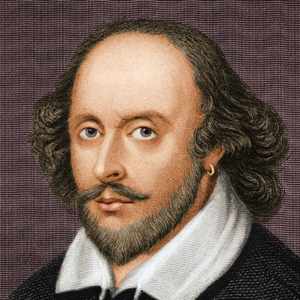
The complete works of Shakespeare were not only codified, but translated into a wealth of languages. Romantic composers who knew and studied Shakespeare composed revivals of his works, such as Mendelssohn with his incidental music to A Midsummer Night’s Dream (1842), Verdi with his opera Macbeth (1847), Tchaikovsky with his overture-fantasia Hamlet (1888), and, perhaps the most influenced of all, there is the case of the French composer Berlioz, who married the Anglo-Irish actress Harriet Smithson, and subsequently composed his opera Romeo and Juliet (1839), overtures to The Tempest, King Lear (1831), Beatrice and Benedict (1862), and incidental music to Hamlet (1852). In the case of Beethoven, who knew Shakespeare in both the Eschenburg and Schlegel translations, Lewis Lockwood notes of, his “avowed admiration for Shakespeare, his thoughts of a possible Macbeath, and the clear evidence that, like any literate German artist or intellectual of the time, he knew the plays.” Beethoven, like many of his contemporaries, was, for lack of a better term, a massive hoarder and a multitude of his non-musical ephemera has come down to us over the years. Macardle notes that “among the books from Beethoven’s library at Berlin were two double volumes of the Eschenburg prose translations, which includes Othello, Romeo and Juliet, Much Ado About Nothing, All’s Well That Ends Well, The Merchant of Venice, The Winter’s Tale, As You Like It, and Love’s Labour’s Lost, all except the last two showing signs of intensive reading (Nohl II 529).”
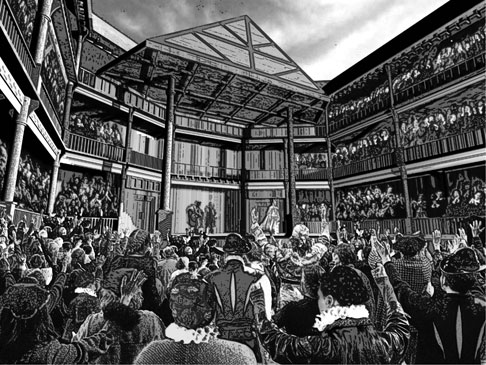
Though there are no indications as to how often he read Hamlet, letters from the composer to various recipients indicate the composer knew the drama well. For instance, in Briefwechsel, p.67, there is a powerful letter from Beethoven to his friend, the violinist Karl Amenda, in which he describes the dichotomies between his “true friends” and his “Viennese friends,” or, in his own words, those “whom I regard merely as instruments on which to play when I feel inclined.” Lockwood notes that it was Anderson who first identified the reference in this line to Hamlet, III, ii, 388-396, in which “Hamlet ironically accuses Guildenstern of treachery,” saying, “You would play upon me; you would seem to know my stops; you would pluck out the heart of my mystery; you would sound me from my lowest note to the top of my compass.”
The works of Shakespeare and the thematic elements emanating from the reading and understanding of these works, became, for Beethoven, the composer’s paradigmatic model on how narrative functioned, as a result, his compositions, especially his symphonic compositions, can be viewed as his own attempt at the musical interpretation of such narrative. One of Shakespeare’s most important narratives is, arguably, Hamlet, The Prince of Denmark, which bows to a plot of uncertainty—our first point of discussion.
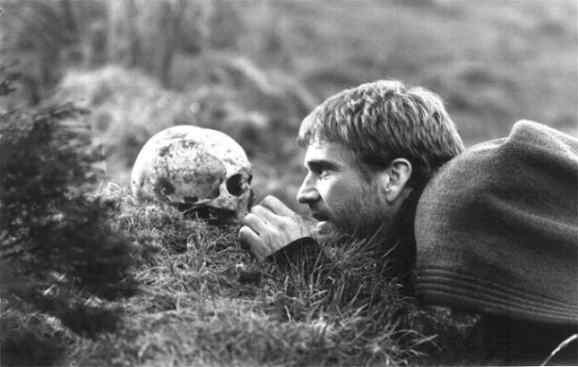
Discussion
To offer a rather brief summarization of Shakespeare’s longest drama, the words of the Shakespearean scholar Dr. William Dyson Wood (1870) are recalled here, “Hamlet, the hero of the play, is the nephew of the reigning monarch of Denmark, and son of the late king, whose window, Hamlet’s mother, married her husband’s brother, the present king. The throne having been usurped by the present monarch, young Hamlet remains deprived of his just title, and, in addition to that, has the mortification of seeing his mother married to the usurper. Hamlet has occasionally dreams and imaginings that his father did not lose his crown by exactly fair means, and his suspicions are at last painfully and vividly realized the appearance of his father’s Ghost, the Ghost informing him that his father was murdered, and that the murder was committed by the usurper, Hamlet’s uncle. The Ghost, in addition to describing the murder, lays on Hamlet the command that the murder is to be avenged, and that Hamlet is to be the avenger.”
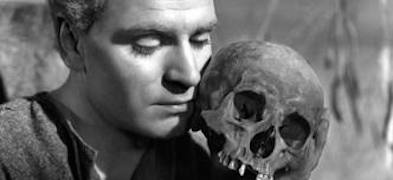
What sets Hamlet apart from other dramas is Shakespeare’s use of uncertainty as an integral dramatic-thematic form. This use can be illustrated on a couple of levels, namely in plot and language. For example, ‘The Mousetrap Scene,” (3.5) of Hamlet is, perhaps, the most obvious level of uncertainty in the plot. The role of the Ghost in this scene is, of course, one of complexity. The following duologue is extracted from the aforementioned scene, more specifically 1.5.7-40.1.
Excerpt from Hamlet, the Prince of Denmark (1.5.7-40.1):
GHOST: So art thou to revenge, when thou shalt hear.
HAMLET: What?
GHOST: I am thy father’s spirit, doomed for a certain term to walk the night,
and for the day confined to fast in fires…If thou didst ever thy dear father,
love – revenge his foul and most unnatural murder.
HAMLET: Murder? […]GHOST: ‘Tis given out that, sleeping in my orchard,
a serpent stung me. So the whole ear of Denmark is by forged process,
of my death rankly abused. But know, thou noble youth, the serpent that did,
sting thy father’s life now wears his crown (1.5.7-40.1).
The understanding and judgment of Hamlet’s behavior in this scene is undoubtedly affected by his academic studies, namely his tenure at The University of Wittenberg, which, notes the Shakespearean scholar Grace Godwin, “influences the fundamental question of whether or not he should, in good faith, trust the Ghost—if he is Catholic, yes; if he is Protestant, no” (Godwin, 2014). Hamlet does not question the existence of the Ghost, however, he does question its fleshly alembic and intention. The uncertainty leads Hamlet to devise The Mousetrap, a play within in a play, which re-enacts the claims of the apparition before the King, who, in Hamlet’s mind, re-acts guiltily. The example of uncertainty in language appears in the departure from standard iambic pentameter, namely the addition of a final, unstressed syllable that creates a so-called weak or feminine ending the use of which is generally seen to indicate a character in uneasiness, tension, and-or doubt. Perhaps the best example of this representation comes from the utterly famous to-be-or-not-to-be soliloquy, which was previously referenced in the introduction.
Excerpt from Hamlet, the Prince of Denmark (3.1):
1 To be | or not | to be: | that is | the question:
2 Whether | ‘tis no |bler in | the mind | to suffer
3 The slings | and ar | rows of | outra | geous fortune,
4 Or to | take arms | against | a sea | of troubles,
5 And by | oppo | sing end them? | To die: | to sleep;
The work of the English literature scholar Deloss Brown adds clarity to this example by stating the “assumption is Shakespeare can write regular iambic pentameter anytime he wants to, and when he varies from it, he has a purpose. If the verse represents the character’s thoughts, we assume that any turbulence in the verse represents some idea that causes the character distress for some reason.” To the contemporary audience, the departure from iambic pentameter might sound like a mistake, but, as they saying guess, there is a method to this madness. Similarly, the same can be said of Beethoven’s Third Symphony, which opens with two attention-demanding chords and initial theme that begs for explanation. Of the iconic opening, Scott Burnham writes, “the listener is immediately put in his or her mettle. Thrown into an unknown situation by the most unsettling of all utterances, the imperious command to do one knows not what.” (Burnham, 2000). The opening chords can be seen in the following excerpt:
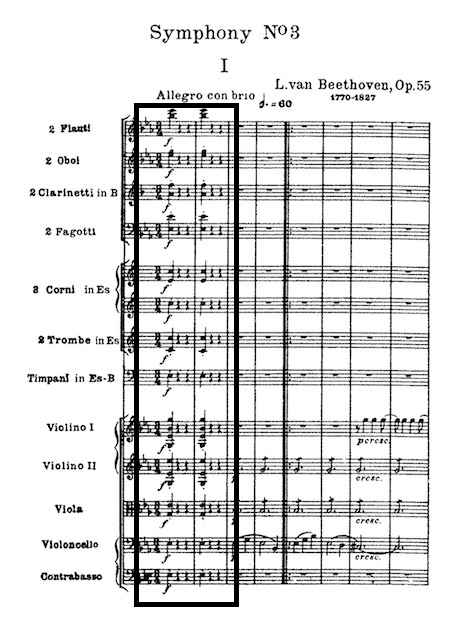
The theme of uncertainty is utterly characteristic of the Romantic era and an integral part of the Third Symphony, which stresses this concept in a number of places. By following the divisions that fueled the earlier part of this discussion, we can see that Beethoven’s use of theme of uncertainty can be illustrated on similar levels. In the very opening of the work, the uncertainty is made clear with the violoncello landing on the C#, a half-step outside of the tonal center:
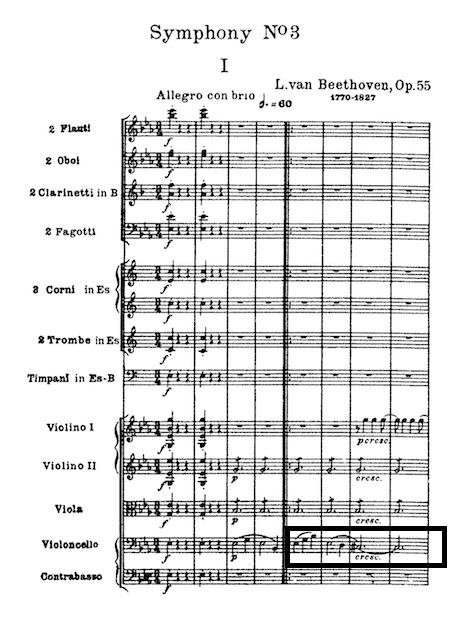
Perhaps the most famous example of uncertainty in plot with regard to the Symphony can be found in the measures that precede the recapitulation of the first movement, which can be heard here and seen in the following excerpt.
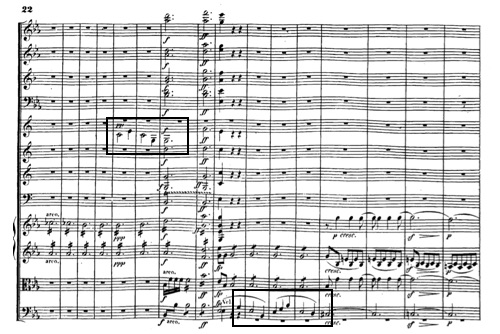
Thomas Sipes (1998) notes that the premature entry of the theme is known to German scholars as the cumulus [outburst] and this particular moment in the Symphony has been the subject of many hours for several scholars. For instance, Lockwood notes that the projection of this uncertainty was an integral part of the re-transition. Sipes continues that, “the drama of the entire movement revolves around this coup de théâtre” (Sipes, 1998). If any moment in Beethoven’s entire output deserves the cliché ‘stroke of genius’ the cumulus surely does.” The premature entry was so disruptive that Ferdinand Ries, a pupil of Beethoven, recalled in his memoir that, “During the first rehearsal of this symphony, which went appallingly, the horn player did come in correctly. I was standing next to Beethoven and believing the entry wrong said: ‘That damned horn player! Can’t he count? – It sounds terrible’ I believe I was very close indeed to having my ears boxed. – Beethoven was a long time in forgiving me.’” If it were Beethoven’s intention to include a coup de theatre in this Symphony, as Lockwood suggests, the events in the measures highlighted above are certainly definitive of this decision. The fact is that the example of uncertainty in language appears all too common in this Symphony.
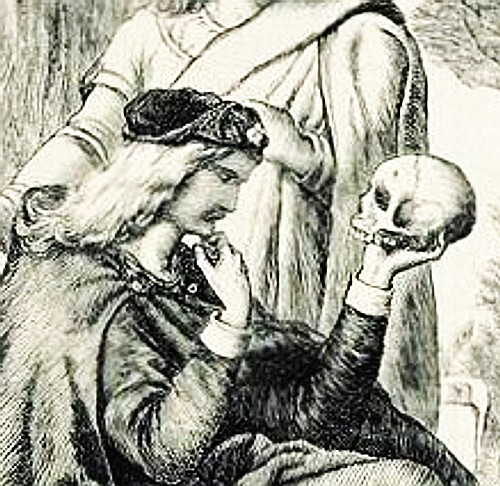
Clearly this analysis is not intending to argue for an exact one-to-one similitude between Shakespeare’s Hamlet and Beethoven Symphony No. 3, but rather to posit a relationship in the narrativity, particularly the narrative of uncertainty. Previous scholars who fall into the more modern mindset, such Rose Subotnik, Lawrence Kramer, the feminist musicologist Susan McClary and her kind, have gone to great lengths and stretches of the imagination to persuade us that “subjectivity” and “musical structure” should be considered and studied as “one-and-the-same.” This study, as well as these efforts, speak[s] to the larger relevance of “narrative” and “musical structure” in musicological discussions. Just as Richard Will notes, “the Eroica asserts the power of the individual bard to teach a society how its history feels and what it means” and McClary notes that, “an unprecedented level of dissonant bashing seems “required” [in the Eroica] to maintain thematic, rhythmic, and tonal identity. The struggle appears justified in the end, however, when we get to hear the uninterrupted transcendence of the theme in its tonic homeland,” the same could be said of our tragic Hamlet, who, in closing, says:
HAMLET: If thou didst ever hold me in thy heart,
Absent thee from felicity awhile,
And in this harsh world draw thy breath in pain,
To tell my story.
[…]
So tell him, with the occurrents, more and less,
Which have solicited. The rest is silence. (5.2)
Works Cited
Ludwig Von Beethoven in Briefwechsel, p.67
Scott Burnham, Beethoven Hero. Princeton University Press, 2000.
Deloss Brown, http://www.delossbrown.com/feminine.htm
Nicholas Cook in Beyond the Soundtrack: Representing Music in Cinema, ed. Daniel Goldmark and Lawerence Kramer. University California Press, 2005.
Grace Godwin, interview with Scholar (2014).
Matthew Guerrieri, The First Four Notes: Beethoven’s Fifth and the Human Imagination. Random House, 2012
Lewis Lockwood, Beethoven: The Man and the Music. W.W. Norton, 2005.
Don MacArdle, Beethoven as I knew Him by Anton Schindler. Courier Corporation, 1966.
Susan McClary, Feminine Endings: Music, Gender, and Sexuality. University of Minnesota Press, 1991.
Thomas Sipes, Beethoven: Eroica Symphony. Cambridge University Press, 1998.
Richard Wagner in Wagner and Beethoven: Richard Wagner’s Reception of Beethoven by Klaus Kropfinger. Cambridge University Press, 1991.
Richard Will, The Characteristic Symphony in the Age of Haydn and Beethoven. Cambridge University Press, 2012.
William Dyson Wood, Hamlet: From a Psychological Point of View. London, 1870.
William Shakespeare, Hamlet, Prince of Denmark (1623).
What do you think? Leave a comment.











I have read this play any number of times. Five times? Seven times? I am just now seeing patterns within the play. Particularly after reading your article!
Nice! That’s how reading works.
These two men, so far removed from each other in space and time, represent two of the main pillars upon which western civilisation is based.
This. Shakespeare, whoever he was, was one of the first men to write of real flesh and blood people, who had both good and bad characteristics. He infused his characters with psychological traits that no-one else had done before him. It has been claimed that Shakespeare invented the concept of modern man, with all his worries and concerns. Beethoven revolutionized music by making it a reflection of his inner struggles and presenting music as a psychological landscape as no-one had done before him. Beethoven exposed his personal vulnerabilities for all to hear. These two men then elevated western culture above its previous purely descriptive level and contributed to the development of secular civilization.
Beethoven was a huge Shakespeare fan. For example, see Romeo and Juliet: Beethoven’s friend Karl Amenda said that the second movement of the string quartet Op.18 #1 took its inspiration from the vault scene in Romeo and Juliet (see also the sketches for that quartet found in the manuscript Grasnick 2)
They both developed and extended the languages they wrote in, inventing new words (harmonic progressions) and made possible much of what we now take for granted in their respective spheres.
Great discussion. When Beethoven died there were four volumes of Schlegel’s translations (into German) of Shakespeare’s plays in his estate.
Oh yeah. I don’t know what happened with the books, but they surely inspired the Tempest Sonata.
Therefore, one of them must have been the play ‘The Tempest’.
There is small point in trying to determine who is the greater among Shakespeare, Dante, Homer, Bach, Beethoven, Michelangelo, Sesshu, Rembrandt, Hokusai, Tu Fu, Lope de Vega, Goethe, to name a few great artists out of the top of my head.
How would you compare them?
Shakespeare is not regarded as history’s greatest artist, but as one of them.
I really recommend reading the book “Beethoven. Biography of a Genius” by George R. Marek. It has quite a few references to Shakespeare, Beethoven’s interest in him, and his works.
Add Hamlet to the list of reads I hated in high school but now love as an adult.
Shakespeare! The man himself! The best writer ever, or else that dude you had to read in high school and he didn’t make any sense.
Hamlet is Shakespeare’s single most-perfect creation, and among the ranks of Falstaff, Iago, Macbeth, as the Bard’s most-memorable creatures.
I can relate to hamlet on various levels, the most prominent of them being procrastination to the extreme.
It was said in earlier conversations that his favorite Shakespeare play was “The Merchant of Venice”.
Beethoven also read Hamlet, The Tempest, Othello, Much Ado About Nothing, All’s Well That Ends Well and The Winter’s Tale.
hey worked in different languages and I love them both.
Hamlet is one of those books people can analyze, discuss, and philosophize about.
Macbeth: Beethoven started an opera Macbeth which never got past a few sketches. He used some of them in the slow movement to the Ghost Trio Op. 70 #1.
One of the last conversations that Beethoven had, that was recorded in one of his conversation books just 3 weeks before his death, shows that B. still held fast to his life-long loves. This subject was Shakespeare.
What a fascinating look at the connections between Beethoven and William Shakespeare’s Hamlet! I feel like I learned a lot from reading your article.
Love this. Both truly are titans in their own right, and the way they stood apart from their respective predecessors truly is what allowed their work to stand the test of time.
Love this. Both truly are titans in their own right. The way they stood apart from their respective predecessors truly is what allowed their work to stand the test of time.
I cannot agree that the opening if the Third Symphony represents uncertainty. It begins with two tonic chords, played forte (loud). Typically, Beethoven would have presented tonic (I) and dominant (V) chords at the outset. (Or, as in the First Symphony, dominant and tonic.) As an example, try hearing the opening as I-V. Or even V-I. Not so. Even the first theme is clearly in the tonic key of E-flat. Not until the 7th measure do we feel the uncertainty of a diminished fifth (C#-G). That ambiguous interval, which can resolve in two different directions, was called the Devil’s interval.
The references to Hamlet are a bit thinly based. This symphony was originally dedicated to Napoleon. Beethoven angrily scratched off the dedication and changed the title to Eroica after Napoleon declared himself emperor. A much more secure argument would have been drawing the parallel between the structure of Shakespeare’s plays and sonata form.
Beethoven’s 3rd symphony was partly inspired by Napoleon